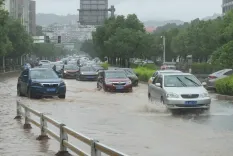Were There Any Abnormalities Found in Contamination Tests Over Suspected North Korea’s Uranium Wastewater Discharge?

Synopsis
Key Takeaways
- No abnormal contamination levels detected in South Korean tests.
- Testing conducted near rivers adjacent to North Korea.
- Uranium levels remain comparable to previous years.
- Maximum allowed uranium level in drinking water is 30 ppb.
- Continued monitoring will take place to ensure safety.
Seoul, July 18 (NationPress) South Korea has reported no abnormal levels of radioactive or heavy metal contamination in its analysis concerning a suspected wastewater discharge from a North Korean uranium refining facility, as stated by the unification ministry on Friday.
In early July, South Korea's nuclear safety authority, in conjunction with the oceans and environment ministries, conducted contamination assessments for uranium, cesium, and five heavy metal variants at ten river locations adjacent to North Korea in relation to the rumored wastewater release.
This action was prompted by a recent news article indicating that North Korea might have released wastewater from a uranium refining plant located in Pyongsan County into the Ryesong River, which flows into South Korea, according to a report by Yonhap news agency.
"The test results showed no abnormalities," said Chang Yoon-jeong, deputy spokesperson for the ministry, during a press briefing.
Uranium levels at six of the ten sites tested near Ganghwa Island and Gimpo ranged from 0.135 to 1.993 parts per billion (ppb) in the latest survey, comparable to levels documented in 2019, which ranged from 0.59 to 1.97 ppb, as per the unification ministry. The average uranium concentration in the Han River, which flows through Seoul, was recorded at 0.31 ppb in 2019.
At the remaining four sites tested, including the estuary of the Han River and Incheon, uranium levels remained within normal parameters, fluctuating from 0.087 to 3.211 ppb. The maximum permissible uranium level in drinking water is 30 ppb, according to the ministry.
However, Chang emphasized that the recent tests were merely a collaborative environmental contamination investigation by South Korean agencies and do not confirm whether the North had indeed released uranium wastewater.
She added that the government will persist in its monthly contamination monitoring at seven major testing sites to help alleviate any public concerns.







